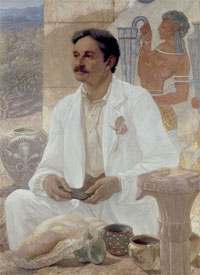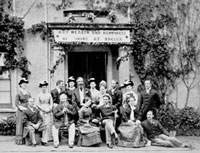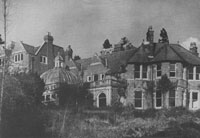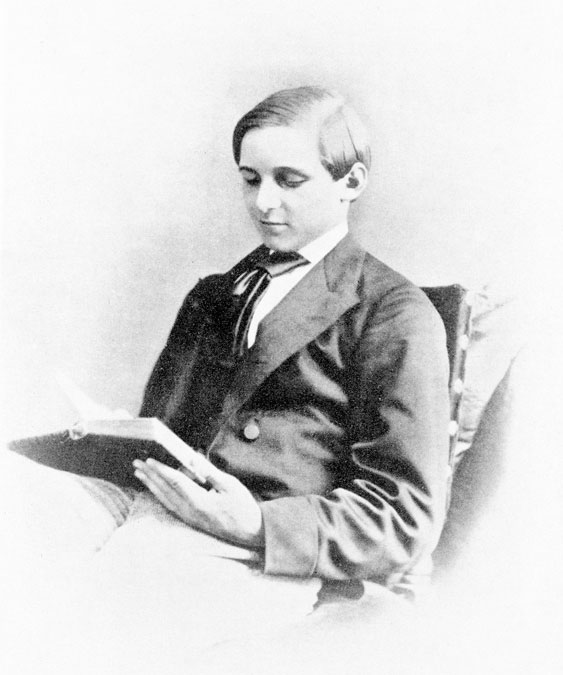Sir Arthur Evans (1851-1941)
Click on image below to see larger version  Arthur Evans by Sir William Richmond, 1907 (Ashmolean Museum WA 1907.2) |
Arthur John Evans was born at Nash Mills on 8 July 1851, the eldest son of John Evans and his first wife Harriet. He had two brothers, Lewis born in 1853, and Philip born in 1854, and two sisters, Alice born in 1856 and Harriet born 1857. His half-sister, Joan, was born in 1893 to Evans's third wife Maria. Arthur resembled his father in looks and ways, and shared many of the same interests. He attended Callipers preparatory school at Chipperfield in Hertfordshire, then went on to Harrow. In October 1870 he went up to Brasenose College, Oxford at the start of his university degree in modern history, where he achieved a first class degree. This university education was a privilege that had been denied to his father. Arthur visited Bosnia, Herzegovina, Finland and northern Scandinavia during his university studies. For some time Arthur Evans acted as the Balkan correspondent for the Manchester Guardian. In 1884 Arthur returned to Oxford, where he was appointed Keeper of the Ashmolean Museum. One of the conditions of the Keepership prescribed travel and lectures. Arthur took full advantage of both. He excavated a Roman villa at Frilford in Berkshire (now Oxfordshire) and an Iron Age cemetery at Aylesford in Kent. He resigned from this post in 1908. When the Ashmolean Museum and the University Galleries were formally amalgamated to form the present Ashmolean Museum of Art and Archaeology. Arthur devoted himself to his Cretan researches maintaining a close connection with the Museum as Emeritus Keeper. Arthur presided over many learned bodies - as had his father, John Evans - among them the Society of Antiquaries and the British Association, and was a trustee of the British Museum. He was a founder of the British School at Athens and of the British Academy. He was the fourth generation of the family to be elected a fellow of the Royal Society. In 1909 he received the gold medal of the Royal Institute of British Architects and in 1911 he was knighted in King George V's coronation honours. |
 Somerleaze |
In September 1878 Arthur married Margaret Freeman at Wookey Parish Church; the wedding photograph was taken outside the Freemans' home, Somerleaze, near Wookey. Margaret was the daughter of the historian Edward Freeman. She became Arthur's devoted soulmate until her death in 1893. She and Arthur had no children. In 1892 Margaret's father died from smallpox while visiting Alicante in Spain. Margaret mourned her father whilst being very ill herself. |
 Youlbury House |
In 1893 he purchased a property just outside Oxford called Youlbury, where he built a large house and created a welcoming place for his family and friends to visit. His sister, Joan, remembers it as an ugly house due to several unattractive extensions. Just before his father died in 1908, the Evans collections were delivered to Youlbury to be housed until Arthur gave the first collection of artefacts to the Ashmolean Museum that year (mostly the Anglo-Saxon objects). In the summer of 1926 the British Association held its meeting at Oxford and Arthur gave a splendid party at Youlbury where he displayed 'his father's and his own collections - stone and bronze, Minoan and Iron Age, Saxon metalwork and medieval jewels, coins and medals' (Time and Chance). It was the last time the collections were displayed together. In 1927 John Evans's prehistoric collections were given to the Ashmolean Museum. In his will Arthur left the remainder of his antiquarian collections to the Ashmolean. Arthur died at Youlbury in 1941 aged 90. He left a large proportion of the grounds to the Scout movement. It is still used by the scouting movement today. The house at Youlbury has since been demolished. |
 Arthur at Knossos |
Arthur Evans will be remembered principally for his excavations at Knossos on the island of Crete (1900-1931). Excavations began at the Kefala hill, the Palace of Minos site, on 23 March 1900. The excavations were reported in the Annual of the British School at Athens, vols 6-11 (1900-1906). He was excavating at Knossos when his father died and Arthur was unable to attend the funeral. Between 1921 and 1936 he published his account of Minoan civilisation and of his excavations at Knossos in the four volumes of the Palace of Minos. |
Further References / Links:Joan Evans, Time and Chance: The Story of Arthur Evans and His Forebears (1943) Joan Evans, Prelude and Fugue (1964) Arthur Evans Archive (Knossos excavations) - Oxford Digital Library (Digitisation project about the archival records of Sir Arthur Evans' work at Knossos, Crete). |
|

